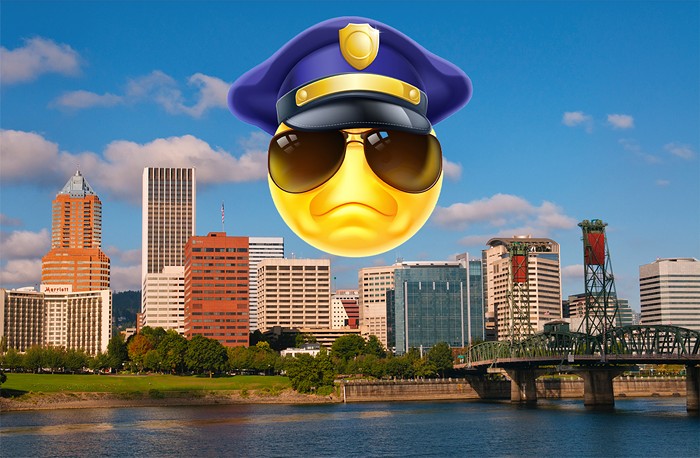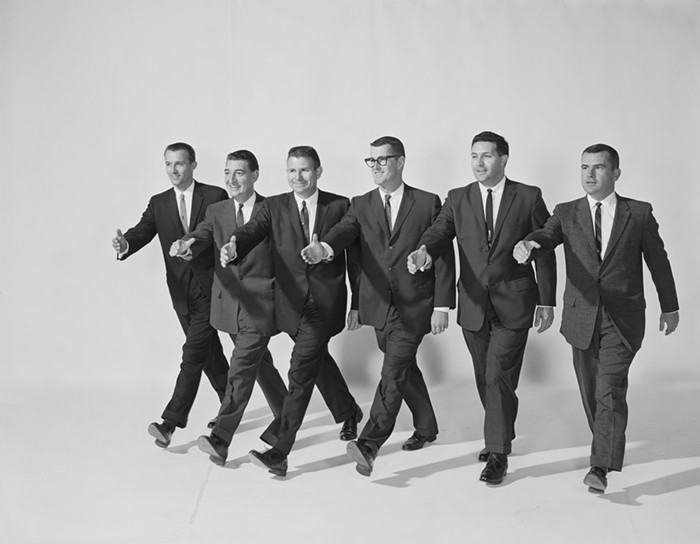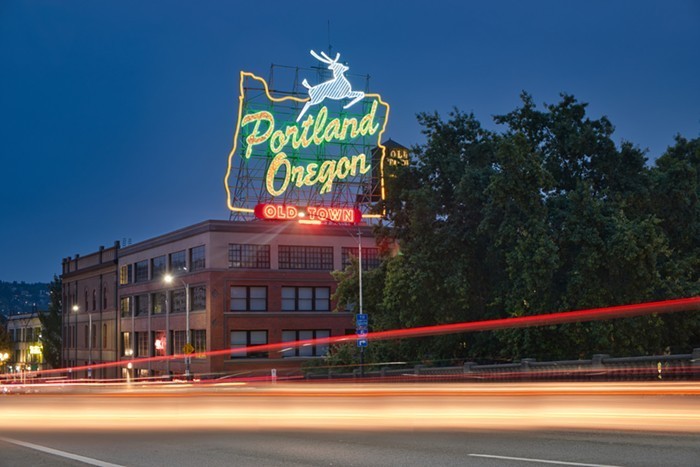THIS IS A STORY about good ol' American ingenuity. It's a story about ambition and processed meat, about believing in dreams and reaching for the stars. It's the story of the first hot dog in space.
It begins in a dank parking garage under the Hawthorne Bridge, behind a nondescript door, down a flight of stairs, and past a rusty boiler room. Down there, in the domain of moss and fluorescent lights, is a sliding door marked "Ruckus Laboratories."
But first, a brief reflection on the symbolic importance of hot dogs.
Hot dogs are purely American—an idea stolen from a long lineage of European sausages and repurposed by immigrants as a cheap stadium food, hot dogs are now a conglomerate-dominated $1.7 billion industry. They're also the most patriotic food: According to the National Hot Dog and Sausage Council (actual slogan: "Relish the Moment") Americans eat 155 million hot dogs on the Fourth of July alone. When American astronauts were stranded in space on the Apollo 13 mission, they ate mostly hot dogs, providing the crucial hit of protein they needed to return to Earth so they could achieve the American dream of being played by Tom Hanks. NASA cemented this patriotism/hot dog/space connection this summer, discovering hundreds of super bright galaxies that officials dubbed Hot Dust-Obscured Galaxies, or Hot DOGs.
Hot dogs, clearly are perfectly designed for space. They are extremely durable, being highly processed and cloaked in a deliciously tough collagen casing. They're aerodynamic, like they were meant to fly through the air.
And yet! No hot dog has ever flown solo into space. This has been a grievous oversight in the otherwise proud history of American aeronautical engineering.
"The hot dog is a proponent of Americana. It's tradition. It's simple. Delicious. Affordable," says Jesse Herzog, a San Francisco real estate developer who runs hot dog stand Zog's Dogs as a Bluth-family-esque side project. "I was extremely worried that another country would send a hot dog into space first. This is a significant frontier for us to explore."
Herzog's father was a hot dog man, briefly, at the 1964 World's Fair in New York, and Herzog has carried on the tradition with Zog's Dogs, which pushes the boundaries of hot dog creativity. Last year, he granted an artist a fellowship to draw customers' portraits in ketchup and mustard. This year, Herzog chose a classic American all-beef frank with a white bun, and decided to find a way to make it the first hot dog in space.
To find a crack space engineer, he turned to Craigslist.
"It was late at night and someone emailed me this weird Craigslist ad," says Shawn Small, engineer at Portland's Ruckus Composites and now a national hero. The ad was looking for someone to launch the world's first hot dog in space. He wrote back and got a quick reply from Herzog: "Why not aspire to the extraordinary? Especially if it means putting a hot dog in the cosmos."
From his Southeast Portland basement lab under the Hawthorne Bridge, Small began devising a plan to send the hot dog into space for a budget of less than $1,000. Ruckus Composites is a carbon-fiber design and manufacturing enterprise that primarily makes bike accessories like fancy racks and fenders. Along with assistant Graham Adams, their small, unassuming lab is lined with pricey racing bikes whose frames have cracked—causalities of car-topping and cyclo-cross accidents—and are awaiting repair.
Small looks like the typical SE Portland bike nerd—a lightly bearded dude with a skinny, plaid-bearing frame—except he's prone to saying things like, "I have a lot of background in high-altitude rocketry."
As future schoolchildren will certainly learn, Small grew up on a Wisconsin dairy farm where his isolated environment led to an interest in building rockets and blowing shit up. In college, he competed in sound-barrier-breaking rocket competitions and was offered a job at NASA, which he turned down—instead moving to Portland to start Ruckus at age 24. Ever since, people have been asking him to build their bad ideas.
"Typically, in this line of business, people have lots of crazy ideas, but no money to back it up," says Small.
"It's always, 'If you make this and don't charge me, we'll make millions!'" adds Adams.
But sending a hot dog into space sounded like an excellent idea. The proposal presented several intriguing challenges.
To launch a hot dog into space would require a super durable spaceship. Shooting up 100,000 feet into the air, the wiener would pass through winds blowing 150 MPH, and reach the freezing, near-vacuum upper limits of the atmosphere. If the hot-dog spaceship was over four pounds, the team would have to get clearance from the Federal Aviation Administration. It needed to be equipped with a video camera—because, really, what's the point without video?—which meant the ship would not only have to fly to space, but return to Earth close to where it launched, on soil easy to get to without use of, say, a submarine or helicopter. It had to be built with off-the-shelf materials for less than $1,000. And, most importantly, the ship had to include a very firmly secured hot dog as a passenger. Lose the hot dog and the mission would be a failure.
The construction material was obvious: carbon fiber, the same lightweight, astoundingly sturdy, well-insulated material that makes high-end racing bikes so feather light and strong. Ruckus used carbon fiber to build an insulated case for a wallet-sized GoPro video camera, GPS unit, and the bun-nestled frankfurter, secured to the outside with wire. To that, they added a high-altitude weather balloon, which scientists use to do things like measure neutrinos in the atmosphere. Then they planned to fill the balloon with helium, expecting it could float at least 10 miles straight up before popping.
Using government atmospheric data and rocket simulation software, Small ran dozens of models—winds could knock the hot dog spaceship hundreds of miles from its launch point. Then Small and Adams spent three months building the hot dog spaceship in their spare time. The resulting craft weighed just 2.5 pounds, so they didn't have to apply for any government permits for the wiener launch. They set a launch date for Saturday, July 21, 2012.
The launch site would be the Oregon desert: wide-open, inland public land with few tall trees for the balloon to get caught in on its fall back to earth.
"Though we did buy a football just in case we needed something to throw at it," says Adams.
Finally, the historic day arrived. Rising before dawn, Small, Adams, Herzog—who traveled up from San Francisco for the occasion—and some onlooker friends drove to the desert land outside Madras, unpacked their spaceship among the sagebrush and began filling up the balloon from a tank containing 100 cubic feet of helium.
The sky was blue. The wind was low. The desert was vast around the men as the balloon slowly inflated, unfolding into the sky.
Then, there was a sputtering. The helium stopped flowing. The rented tank was short by 40 cubic feet. Disaster was nigh.
Surely, there are few sadder places to be than the middle of the desert, holding a half-inflated balloon that is attached to a hot dog.
Luckily for America, engineer Small had a flash of brilliance. Welders use helium. There must be a welder somewhere in Central Oregon who was awake on a Saturday morning and could lend some helium to the noble cause. Small began calling welding stores and, miracle of miracles, someone answered the phone at a store in Madras.
"Sure," said the old man who answered. "I got helium right here." Small and Herzog sped off in the truck, leaving Adams holding the half-inflated balloon, unable to let go.
By and by, various onlookers passed, intrigued by the sight of a young fellow holding tightly onto a giant balloon amid the barren landscape. A pair of people on horses clip-clopped near and paused to ask what Adams was doing. He explained and one of the cowboys smiled and shook his head.
"Now I've heard of everything," he said, trotting away.
Eventually, the helium team returned victorious. The crew inflated the balloon and, with a moment of fear, let it go. It floated up, up, hundreds of feet up. The team of friends squinted into the sun.
"Looks like something fell off," someone said.
Hearts sank. It was likely the hot dog, though it had been skewered and sewn into place. The mission was sure to be a flop. There was nothing to do but go get breakfast and glumly watch the GPS data coming in from the little ship. After several hours, the crew could see that the craft had come back to earth and landed about 50 miles northeast of the launch site. They drove after it, offroading in their rental car until they reached the banks of the John Day River. Parking the car, they rolled up their pants and waded across the chilly river in bare feet, then scoured the dusty land for any sign of the brave wiener. And there it was! Amid the sagebrushes was the ship, intact with hot dog! There was much hooting and hollering.
Together, the team took bites of the historic frank.
"It was delicious," says Herzog. "It had this very distinct crispness that I think can only come from the stratosphere."
"It was desert sun-cooked," remembers Adams.
"It had been in the dirt about an hour," says Small.
Reviewing the video, the hot dog's journey is a beautiful sight. The beef tube flies away from the desert sand, up into the bright-blue atmosphere that few humans will ever see firsthand. At the height of its voyage, the idyllic blue curve of Earth bends down below the dog, surrounded by a serene white aura. Then the balloon pops and the frank hurtles back earthward, from whence it came.
Inspired, Herzog now plans to send a hot dog to the lowest point in the ocean. For their efforts, Small and Adams have received no medals. They haven't even received any money, since almost all of Herzog's $1,000 budget went toward building expenses. But they have received a much greater reward: glory.
"Everyone in my grandma's retirement home knows about the hot dog in space," says Adams.
"And no one believes it," says Small.













